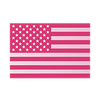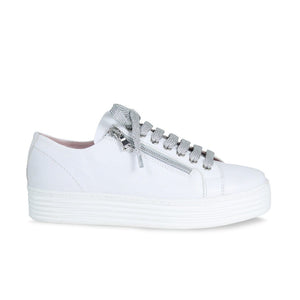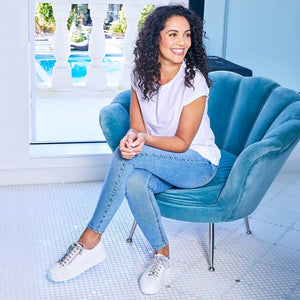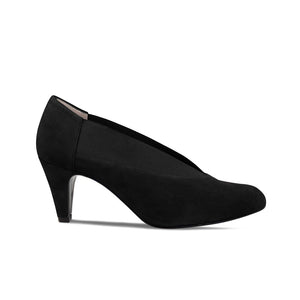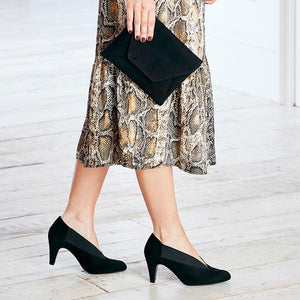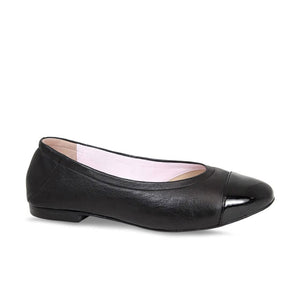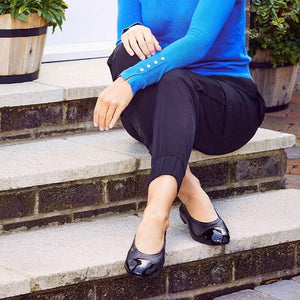Causes, Prevention and Best Shoes for Relief from Corns & Calluses
Corns and calluses are common foot conditions that affect many people, often causing discomfort and pain. If you're a corn or callus sufferer, you may be asking why do we get calluses on our feet. These thickened patches of skin can make walking and wearing shoes an uncomfortable experience, but fear not there are plenty of comfortable and stylish shoes for corns and callused feet.

Hero: Navy Leather - Best Shoes for Corns & Calluses
SHOP NOW
In this blog post, we will explore what corns and calluses are, why do we get calluses, and most importantly, how you can find relief through proper shoe selection with Sole Bliss! Let's dive into the details of these foot conditions and learn how to manage them effectively. Step this way for the best shoes for corns and the best shoes for calluses!
What are Corns?
Before we show you the best shoes for corns, it is important to understand what are corns. Corns are small, localized areas of thickened and hardened skin that typically form on and inside the toes and balls of the feet.

Ruby: Metallic Taupe - Cushioned Heels for Corns & Calluses
SHOP NOW
They may have a cone-shaped or circular appearance with a central core, which can be painful when pressed. Corns are caused by repetitive friction or pressure on specific areas of the foot, usually from ill-fitting shoes. So it is important to wear comfortable shoes for corns.
What are Calluses?
Calluses, like corns, are areas of thickened skin, but they are larger and broader. They often develop on the soles of the feet, heels, or other weight-bearing areas. Unlike corns, calluses do not have a central core and are generally less painful.

Star: Pale Taupe Leather - Best Sneakers for Corns and Calluses
SHOP NOW
How are Calluses Formed?
Calluses form as a natural protective response to friction and pressure on the skin. They are a common issue for those who spend extended periods on their feet or engage in activities that cause repetitive rubbing or pressure, like exercise or lifting weights.
How are Calluses & Corns Aggravated?
Corns and calluses can be further aggravated by certain factors, making them more painful and bothersome. Some of these factors include:
Prolonged standing: People who spend long hours standing or walking on hard surfaces are more prone to developing calluses and corns.
Shoes with narrow toe boxes: Tight-fitting shoes, especially those with narrow toe boxes, can squeeze the toes together, leading to friction and pressure points that contribute to the formation of corns.
Toe friction: Corns can develop when toes rub against each other due to improper alignment or crowding in narrow shoes. The best shoes for corns and calluses tend to be wider across the toe-box.

Tanner: Chestnut Leather - Loafer Shoes for Corns & Calluses
SHOP NOW
Pressure from high-heeled shoes: High-heeled shoes shift the body's weight forward onto the toes, causing increased pressure on the ball of the foot and increasing the likelihood of developing calluses. If you are looking for heels for corns and calluses, Sole Bliss has got you covered! Browse our collection of heeled shoes for corns and bunions.
Obesity: Excess body weight puts added pressure on the feet, leading to increased friction and callus formation.
Flat feet: Individuals with flat feet have reduced arch support, which can cause uneven pressure distribution and lead to callus formation. Read more information on flat feet and the best shoes for flat feet here!

Sprint: Navy Leather & Denim - Cushioned Sneakers for Calluses
SHOP NOW
Bunions: Bunions, a bony bump that forms at the base of the big toe, can cause friction against shoes and contribute to corn development. Sole Bliss specializes in the best shoes for bunions and similar foot conditions. Read more about what makes our shoes so comfortable for bunions here.
High arches: High arches can concentrate pressure on specific areas of the foot, leading to callus formation.
Hammertoes: Hammertoes, a condition where the toe joints become deformed and bend downward, can lead to corns due to increased pressure on the tops of the toes. Read more information on hammer toes and the best shoes for hammer toes here!
What Causes Calluses and Corns?
Calluses and Corns are primarily caused by repetitive friction and pressure on the skin. The following factors can contribute to their development:
Prolonged standing: As mentioned earlier, spending long periods standing or walking can lead to excessive friction and pressure on the feet, resulting in corns and calluses.
Shoes with narrow toe boxes: Tight and ill-fitting shoes force the toes into unnatural positions, leading to rubbing and pressure points that cause corns. When it comes to the best shoes for corns and calluses, look for wider-fitting shoes, especially in the toe-box.
Toe friction: When toes rub against each other due to crowding or misalignment, corns can form at the points of contact.

Nova: Black Suede - Low Heels for Corns
SHOP NOW
Pressure from high-heeled shoes: High heels shift body weight onto the toes, causing increased pressure on the ball of the foot, leading to callus formation.
Obesity: Excess body weight increases pressure on the feet, contributing to the development of calluses.
Flat feet: Flat feet can cause uneven weight distribution, resulting in increased friction and pressure, leading to calluses.

Meredith: Pale Gray Suede & Silver Snake - Heels for Calluses
SHOP NOW
Bunions: Bunions cause the big toe to angle towards the other toes, causing friction against shoes and leading to corn development.
High arches: High arches can concentrate pressure on specific areas of the foot, leading to callus formation.
Hammertoes: Hammertoes can cause increased pressure on the tops of the toes, resulting in corns.
Calluses vs Corns
Although corns and calluses share similar characteristics, they have some key differences:
Appearance: Corns have a more defined, hardened, and sometimes painful centre, while calluses are broad, thickened areas of skin with no central core.
Location: Corns typically form on the toes or between toes, while calluses usually develop on the soles of the feet, heels, or other weight-bearing areas.

Luna: Black Leather & Patent - Soft Flat Shoes for Calluses
SHOP NOW
Pain: Corns are often more painful than calluses due to their concentrated pressure on a specific point.
Causes: Corns are commonly caused by tight shoes or toe friction, while calluses are generally the result of prolonged pressure on the skin.
The Best Shoes for Corns and Calluses and Features to Look For
When dealing with corns and calluses, wearing the right shoes is crucial for providing relief and preventing further irritation. Here are some essential features to look for in shoes for corns and calluses:

Hero: Black Leather - Best Sneakers for Bunions and Corns
SHOP NOW
High quality: Invest in well-constructed shoes made from breathable and durable materials like high-quality leather.
A good fit, no rubbing or pressure points: Shoes should fit properly, allowing enough space for the toes and preventing friction or pressure points.
Cushioning: Shoes with adequate cushioning provide extra support and reduce pressure on sensitive areas of the feet.

Luna: Black Weave Leather - Ballet Flats for Calluses
SHOP NOW
Ergonomic design: Shoes with ergonomic features support the natural shape and movement of the foot, reducing discomfort.
Extra depth: Shoes with extra depth provide more space for the toes and can accommodate orthotic inserts if necessary.
Stretchable uppers: Stretchable materials in the shoe uppers can prevent unnecessary rubbing and pressure on corns and calluses.

Mercy: Black Suede - Best Heeled Shoes for Corns
SHOP NOW
Wide toe boxes: Shoes with wider toe boxes allow the toes to spread out naturally, reducing friction and pressure.
Supportive soles: A supportive sole structure helps distribute body weight evenly, reducing pressure points.
Shock absorption: Shoes with shock-absorbing properties can reduce the impact on the feet when walking or standing.

Hero: White Leather - Supportive Shoes with Wide Fitting
SHOP NOW
Which Shoes Should You Wear for Corns and Calluses?
Now that we understand the features to look for in shoes for corns and calluses, let's explore the best shoes for different occasions:
#1 Best Boots for Corns and Calluses:
Look for boots with extra memory-foam cushioning and a wide toe box to accommodate any painful joints or width.
Choose boots made from soft leather or suede to prevent friction and pressure points.

Tread: Black Leather - Boots for Corns & Calluses
SHOP NOW
Leather softens the more you wear them which is why it is the best material for shoes!
Consider boots with shock-absorption. All hikers and everyday walkers should look for boots that offer shock absorption to reduce impact whilst walking.
#2 Best Flats for Corns and Calluses:
Opt for flats with a cushioned foot-bed and arch support to relieve pressure on the soles of the feet. All Sole Bliss shoes are equipped with 3 Layers of Memory-Foam cushioning and a contoured footbed to give you custom support.

Pixie: Navy Leather & Suede - Wide Toe Box Sneakers
SHOP NOW
Look for flats with a wider toe box to prevent toe crowding and rubbing whilst avoiding flats with pointed toe designs as they can aggravate corns and calluses if they are too narrow for you.
#3 Best Sandals for Corns and Calluses:
Select sandals with adjustable straps to ensure a secure and comfortable fit.

Walker: Cream Leather - Adjustable Sandals for Corns and Calluses
SHOP NOW
Look for sandals with a contoured foot-bed to support the arches and reduce pressure on the soles. Choose sandals with soft and cushioned soles to provide shock absorption.
#4 Best Work Shoes for Corns and Calluses:
Opt for work shoes made from breathable materials to prevent excessive sweating and discomfort.
Sole Bliss shoes are made from high-quality Italian leather which is a naturally breathable material which is best for footwear.

Layton: Black Leather - Work Shoes for Corns and Calluses
SHOP NOW
Choose work shoes with good arch support to promote proper foot alignment and to prevent the inwards rolling of the foot. Our Sole Bliss loafers, closed back flats and heels all offer suitable arch-support!
Look for work shoes with Memory Foam cushioning in the soles to reduce pressure. All Sole Bliss shoes are equipped with 3 Layers of Memory Foam cushioning built underfoot, providing ultimate comfort and support.
#5 Best Heels for Corns and Calluses:
If you wear heels, choose ones with a lower heel height to reduce pressure on the ball of the foot. Other suitable heels for corns and calluses have thick platforms and sturdy block heels.

Ruby: Pale Gold & Snake - Comfortable Platform Heels for Painful Feet
SHOP NOW
Sole Bliss heels offer 3 Layers of Memory Foam Cushioning to alleviate further pain and pressure, however we wouldn't recommend trying anything too high if you are not an experienced heel wearer!
Consider wearing heels with open-toe designs to minimize pressure on corns. All square toe, round toe and open toe heels are the better option if suffering with painful corns or calluses.

Venus: Black Suede - Square Toe Heels for Corns & Calluses
SHOP NOW
Can Lifestyle Cause Corns and Calluses?
Yes, lifestyle factors can contribute to the development of corns and calluses. Engaging in activities that involve prolonged standing, walking, or wearing ill-fitting shoes regularly can increase the risk of corns and calluses. Additionally, individuals with certain foot conditions such as flat feet, high arches, or bunions may be more prone to these skin conditions.
To minimize the impact of lifestyle on corns and calluses:
Choose appropriate footwear for different activities to reduce friction and pressure on the feet.
Take breaks and rest your feet if you spend long hours standing or walking.
Avoid wearing high heels or tight shoes on a daily basis.
Ensure that your shoes fit properly and offer adequate support and cushioning.

Tanner: Denim Leather - Loafers for Painful Feet
SHOP NOW
Treating Corns and Calluses
While proper shoe selection is essential for preventing corns and calluses, here are some additional tips to help manage and treat these foot conditions:
Moisturize: Regularly apply moisturizing cream to keep the skin soft and reduce the risk of corns and calluses.
Exfoliate: Use a gentle foot scrub or pumice stone to remove dead skin and keep the affected areas smooth.
Wear the Right Shoes: As emphasized earlier, wearing well-fitting shoes with the right features can prevent and alleviate corns and calluses.
Wear Comfortable Socks: Choose socks made from moisture-wicking materials to keep your feet dry and comfortable.
Limit Time Wearing High Heels: If you must wear heels, limit the time spent in them and give your feet a break afterward.
Corns and calluses can be painful and frustrating, but with the right knowledge and appropriate footwear, you can effectively manage these foot conditions. Remember to look for shoes with the essential features we discussed to reduce friction and pressure on your feet.

Lydia: Navy Suede - Comfortable Flats for Problem Feet
SHOP NOW
By taking care of your feet and wearing the right shoes, you can walk with comfort and confidence, even if you suffer from corns and calluses. Prioritize foot health, and your feet will thank you!

